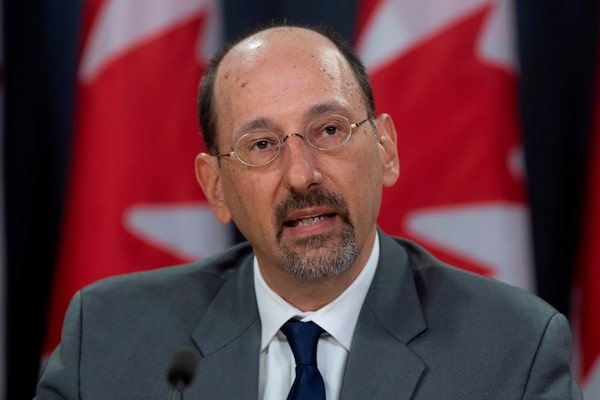
Correctional Investigator Ivan Zinger says COVID-19 measures led to the cancellation of many programs throughout the prison system, creating an idle and combustible prison population.The Canadian Press
The rate of violence in federal penitentiaries has escalated so severely in recent years that Canada’s correctional ombudsman is warning of the potential for mass disturbances.
Figures compiled by the Office of the Correctional Investigator and obtained by The Globe and Mail through access to information legislation confirm that both assaults on prison staff and assaults between prisoners have risen sharply of late.
The figures have created a rare point of alignment between Correctional Investigator Ivan Zinger, who acts as an ombudsman for federally sentenced prisoners, and the Union of Canadian Correctional Officers, which has long warned of increasing dangers facing its 7,300 members.
In past years, the Correctional Investigator challenged the union’s complaints with assault stats showing relatively stable numbers over time. This year, things look different.
“This time we looked at the data, and it does show what [the union is] saying: Assaults on staff and between inmates are up,” Mr. Zinger said in an interview. “And that’s always a red flag because that can be a precursor indicating dissatisfaction in prisons that can lead to major disturbances or even riots.”
Mr. Zinger collated the numbers based on data obtained from the Correctional Service of Canada. They show that physical assaults on prison staff jumped to 327 from 113 between 2014-15 and 2023-24 – a 189-per-cent increase.
Prisoner-on-prisoner assaults, meanwhile, surged by 132 per cent to 1,331 from 573 over the same span. Prisoner fights and assaults on staff using bodily fluids and waste are also up sharply.
CSC spokesperson Kevin Antonucci said the agency could not verify the precise numbers provided by the Correctional Investigator. He did, however, provide internal assault numbers recorded between 2019 and Sept. 30, 2023, that displayed a similar upward trend.
Mr. Antonucci listed several measures in place to keep staff and prisoners safe, adding that a small number of prisoners account for repeated assaults against staff, so “those incidents are not representative of an overall increase in institutional violence by the broader offender population.”
While the ombudsman and the correctional officers’ union agree on the trend of violence in federal penitentiaries, they differ on the cause.
Mr. Zinger explained that COVID-19 measures led to the cancellation of many programs throughout the prison system, creating an idle and combustible prison population.
Completion rates for educational programming remain low, he said. Greater access to school, leisure opportunities, work, vocational training and mental-health resources would all help, he added.
The union, meanwhile, contends that new legislation intended to eliminate solitary confinement has led to an increase in violence.
“The morale of correctional officers over the past few years has decreased with the loss of some of these tools we once had to control more aggressive behaviours,” said Jeff Wilkins, the union’s national president.
One of those tools was segregation, where prisoners could be placed in isolation for upward of 22 hours a day without meaningful human contact.
Opinion: Putting migrants in federal prisons is unjustified and unjust
Multiple court challenges rendered the segregation unlawful. The government ended the practice in 2019, replacing it with something called structured intervention, in which prisoners must be offered at least four hours a day outside their cells, including two hours of interaction with other people.
Those time provisions have made structured-intervention units attractive to many prisoners, Mr. Wilkins said. He alleges that some commit assault specifically to gain entry, a phenomenon Mr. Zinger also acknowledges.
“When it’s free rein in the institution, unfortunately the inmates are going to play,” Mr. Wilkins said. “And that comes at the detriment of our membership.”
The union has also argued that squadrons of drones are bringing potent drugs and weapons inside prison walls, driving a violent underground drug trade. In 2023, the union’s members seized 241 cellphones, 41.5 pounds of marijuana, 2.67 pounds of methamphetamine, nearly a pound of fentanyl and 354 weapons from captured drones.
“And we’re not talking a typical shank made from a razor blade attached to a toothbrush. These are weapons you’d buy in a store, and ceramic weapons that can penetrate stab-resistant vests like butter and don’t go off in metal detectors.”
Mr. Zinger questioned the union’s assertions about increased drug activity, citing mass urinalysis of prisoners for the presence of drugs: “For the last decade, it’s remained pretty stable around 6 or 7 per cent.”
Lee Chapelle, who spent years behind bars and now runs a successful consultancy that prepares people for life in a prison, says an element of physical risk has always pervaded life inside, but that his clients have reported a pronounced increase in violence over the course of the pandemic.
COVID-19 led to backlogs throughout the criminal courts, creating overcrowded tinderbox conditions within penitentiaries, he said. His clients are waiting six to eight months before they can get a correctional plan in place.
“It’s next-level,” Mr. Chapelle said of the assaults. “One of the things about prison is that it is a microcosm of the world. All the divisiveness we see in the general public, there’s a direct correlation between that and what’s going on inside.”
 Patrick White
Patrick White